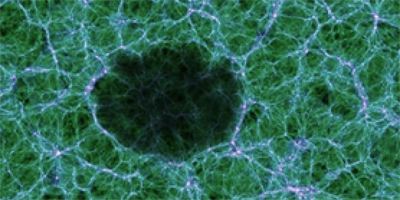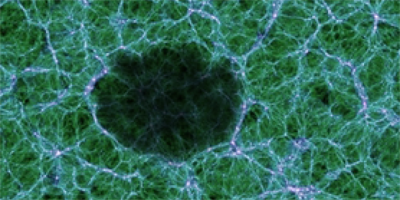Seeing into the Void
The mass concentrated inside a cluster of galaxies warps the surrounding spacetime, causing background galaxies to appear brighter or distorted. A similar sort of “gravitational lensing” occurs for light passing through a void with lower-than-average density. The standard approach predicts that these low-mass regions cause a dimming, but new calculations in Physical Review Letters show that cosmic voids can actually produce brightening that overwhelms the standard lensing signal. The results may affect the interpretation of large-scale astronomical surveys.
Astronomers measure gravitational lensing to obtain the mass of the lensing object, or to estimate the mass density along a particular line of sight. Most of the emphasis has been on high concentrations of mass, but light will also be affected by galaxy-poor voids, which are tens to hundreds of millions of light years across and together account for more than half the volume of the universe. Previous lensing models considered only the light-bending aspect of a void, which causes a background object to appear smaller (and thus slightly dimmer) than it really is.
Krzysztof Bolejko from the University of Sydney in Australia and his colleagues made a more careful accounting of the lensing by voids. In their full relativistic analysis, they included a wavelength-stretching effect that occurs because voids are expanding faster than the universe in general. This added “redshift” leads to an overestimate of the distance to objects sitting near the far side of a void, and thus they will appear brighter than expected. The authors speculate that this void effect may explain some statistical anomalies in supernovae surveys. – Michael Schirber





